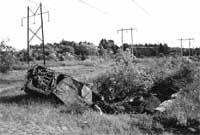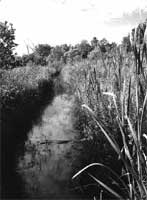
Promoting Cooperation to Maintain
and Enhance
Environmental Quality in the Gulf of Maine
Winter 2001
|
|
|
About |
|
Regular columns |
|
Archives |
By Maureen Kelly
Off the cul-de-sac of Buckminster Road, between two houses with manicured lawns, juts another road. The offshoot road ends prematurely, however, and at pavement’s edge, a wild growth of thick grasses, tall as a person, takes over. Beyond is the Great Bog, 600 acres of some of the most unique wetland habitat in New Hampshire. A local developer planned to extend this road into a 70-acre (28-hectare) upland island in the bog and build a 25 to 27 homes on the hill, until local residents found a way to stall the construction and preserve the land permanently.
 Old
junk cars like this were found in several locations. Photo courtesy of the
Seacoast Land Trust
Old
junk cars like this were found in several locations. Photo courtesy of the
Seacoast Land Trust
In 1999, Mayor Evelyn Sirrell and other citizens of Portsmouth learned of the advancing development while Ocean Road Development Corporation awaited a permit from the U.S. Army Corps of Engineers to dredge and fill 34,226 square feet (3,000 square hectares) of wetlands. They became concerned that the building of the new road and homes would increase pollution since run-off of lawn fertilizers and pesticides would flow downhill into the wetlands.
“We were mainly concerned about the water supply,” Sirrell said.
Portsmouth’s public wells depend on the bog and other nearby wetlands for recharging the water supply. The bog, which feeds into Great Bay, is one of the largest seepage swamps in the eastern United States. Seepage swamps, which are uncommon in New Hampshire, purify water as it filters through the ground to the aquifer below.
The new threat to water quality was of particular concern since Portsmouth had lost a source of drinking water in the mid-1970s, when testing found that a well beneath Pease Air Force Base, now Pease International Tradeport, was contaminated with trichloroethylene, a solvent used to degrease machinery (following a major clean-up effort, the well is back in operation).
 The
bog’s meadow flowers attract yellow swallowtails. Photo: Don Green
The
bog’s meadow flowers attract yellow swallowtails. Photo: Don Green
Responding to a local citizens’ petition regarding the Great Bog, Sirrell arranged a public hearing with the Army Corps of Engineers. Over 100 people turned out to express concerns about how the development would impact water quality and the environment. The Corps ultimately determined that the developer would need a water quality permit from the New Hampshire Department of Environmental Services (DES), which was subsequently denied.
While the Ocean Road Development Corporation appealed the DES decision, a grassroots effort to save the bog from future development was underway. The Mayor formed the Blue Ribbon Committee on The Great Bog and gave the group the task of finding a way to purchase the land from its owners at fair market value. While the committee sought grant money for the purchase, local residents raised money by selling T-shirts.
The meeting with the Corps was “a galvanizing event in Portsmouth” that “crystallized awareness” among the citizens that over-development needed to stop, said Steve Miller, one of eleven members of the committee.
“The Great Bog is the biggest undeveloped space in Portsmouth,” he said. “Over the years, development had nibbled away at the Bog.”
Today, the land is framed by Interstate 95, secondary roads and railroads, and bisected by power lines. People have used it as a dumping ground for old automobiles and other refuse.
The Great Bog is the
largest undeveloped space
in Portsmouth and one of
the largest seepage swamps
in the Northeast U.S.
Nevertheless, the bog is important habitat for a variety of wildlife including fox, coyote, beaver, reptiles and amphibians. It offers deer wintering habitat and potential habitat for spotted and Blanding’s turtles. The bog is visited by over 100 bird species, many of which use the land for breeding or as a stopover during migration.
One evening last fall, Stephen Mirick, a member of the Board of Trustees for the Audubon Society of New Hampshire and an active volunteer, spent just over an hour counting birds as they flew into the bog to roost. He tallied an estimated 75,523 birds, including common grackles, European starlings, red-winged blackbirds and brown-headed cowbirds. Birds roost in the bog at night to avoid predation, Mirick said.
“The birds travel from many miles away just to spend the night in the bog and disperse to feed during the day,” he said.
The bog is also home to a number of species of trees and plants that are rare in New Hampshire. It contains an Atlantic white cedar swamp, which are uncommon throughout the United States.
 Open
water and marsh on the east side is a preferred habitat for ducks and
beavers. Photo courtesy of the Seacoast Land Trust
Open
water and marsh on the east side is a preferred habitat for ducks and
beavers. Photo courtesy of the Seacoast Land Trust
In April 2001, the city purchased 207 acres (83 hectares) of this ecologically important habitat for $500,000 (CND$799,000) with grants from the National Oceanic and Atmospheric Administration (NOAA), National Fish and Wildlife Foundation, and New Hampshire’s DES. U.S. Senator Judd Gregg helped the city to secure $300,000 (CND$480,000) from NOAA, part of a $19 million (CND$30 million) grant that the agency awarded to the Great Bay Resource Protection Partnership.
Now, the Seacoast Land Trust is spearheading the bog cleanup. Last July, it organized the removal of junk from the site, from old couches to torched and abandoned vehicles. More work needs to be done to restrict motorized access and educate people that the bog is not a dump, said Danna Truslow, the Trust’s executive director. She foresees that the bog will be a place where the public comes to take nature walks or cross-country ski.
While the cleanup continues, Portsmouth is looking to acquire more parcels within the bog. “Today, the city is more pro-active with conservation,” Miller said.
Portsmouth citizens are continuing to take an active approach to controlling development in their city, as well. Since the bog undertaking, thirty neighborhood groups have become involved with an effort to convince Pease Development Authority to increase the buffer between the wetlands and development on the former Air Force base from 25 feet (7.6 meters) to 100 feet (30 meters), Sirrell said.
“We have to start preserving what little open space we have left,” she said.